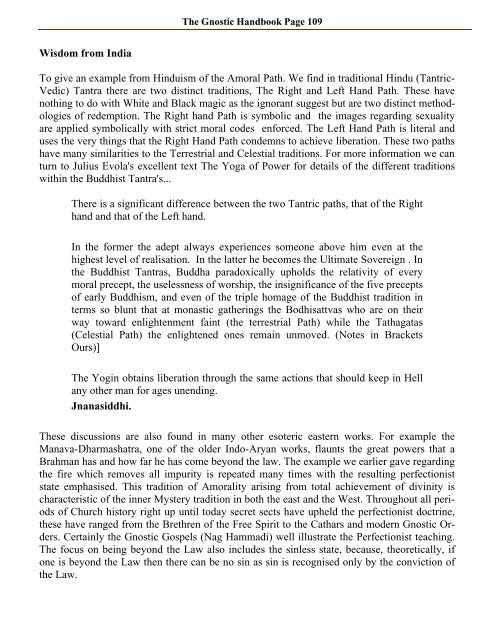gnostic handbook
gnostic handbook
gnostic handbook
Create successful ePaper yourself
Turn your PDF publications into a flip-book with our unique Google optimized e-Paper software.
The Gnostic Handbook Page 109<br />
Wisdom from India<br />
To give an example from Hinduism of the Amoral Path. We find in traditional Hindu (Tantric-<br />
Vedic) Tantra there are two distinct traditions, The Right and Left Hand Path. These have<br />
nothing to do with White and Black magic as the ignorant suggest but are two distinct methodologies<br />
of redemption. The Right hand Path is symbolic and the images regarding sexuality<br />
are applied symbolically with strict moral codes enforced. The Left Hand Path is literal and<br />
uses the very things that the Right Hand Path condemns to achieve liberation. These two paths<br />
have many similarities to the Terrestrial and Celestial traditions. For more information we can<br />
turn to Julius Evola's excellent text The Yoga of Power for details of the different traditions<br />
within the Buddhist Tantra's...<br />
There is a significant difference between the two Tantric paths, that of the Right<br />
hand and that of the Left hand.<br />
In the former the adept always experiences someone above him even at the<br />
highest level of realisation. In the latter he becomes the Ultimate Sovereign . In<br />
the Buddhist Tantras, Buddha paradoxically upholds the relativity of every<br />
moral precept, the uselessness of worship, the insignificance of the five precepts<br />
of early Buddhism, and even of the triple homage of the Buddhist tradition in<br />
terms so blunt that at monastic gatherings the Bodhisattvas who are on their<br />
way toward enlightenment faint (the terrestrial Path) while the Tathagatas<br />
(Celestial Path) the enlightened ones remain unmoved. (Notes in Brackets<br />
Ours)]<br />
The Yogin obtains liberation through the same actions that should keep in Hell<br />
any other man for ages unending.<br />
Jnanasiddhi.<br />
These discussions are also found in many other esoteric eastern works. For example the<br />
Manava-Dharmashatra, one of the older Indo-Aryan works, flaunts the great powers that a<br />
Brahman has and how far he has come beyond the law. The example we earlier gave regarding<br />
the fire which removes all impurity is repeated many times with the resulting perfectionist<br />
state emphasised. This tradition of Amorality arising from total achievement of divinity is<br />
characteristic of the inner Mystery tradition in both the east and the West. Throughout all periods<br />
of Church history right up until today secret sects have upheld the perfectionist doctrine,<br />
these have ranged from the Brethren of the Free Spirit to the Cathars and modern Gnostic Orders.<br />
Certainly the Gnostic Gospels (Nag Hammadi) well illustrate the Perfectionist teaching.<br />
The focus on being beyond the Law also includes the sinless state, because, theoretically, if<br />
one is beyond the Law then there can be no sin as sin is recognised only by the conviction of<br />
the Law.


